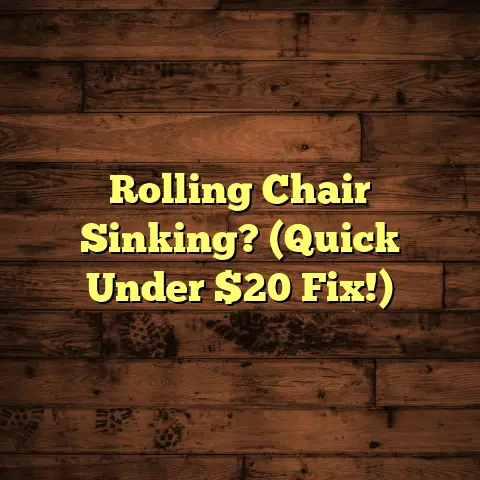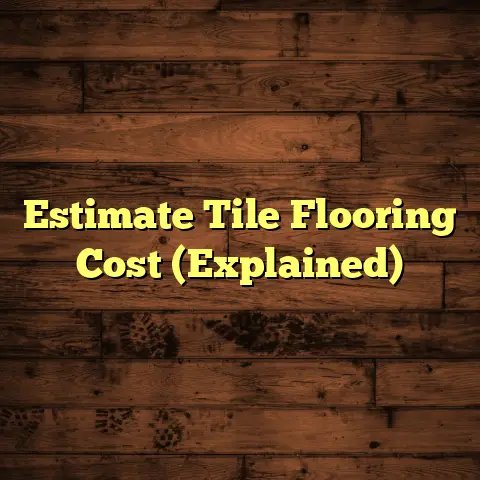Peel & Stick Laminate: Easy? (2 Install NIGHTMARES!)
(2 Install NIGHTMARES!)
Ever seen those ads promising effortless flooring with peel & stick laminate and thought, “Finally, a weekend project I can actually handle?”
I get it. I’ve been a flooring contractor for over 15 years, and even I was intrigued by the promise of easy installation.
But is the promise of an easy DIY flooring solution too good to be true when it comes to peel & stick laminate?
Let’s dive into the nitty-gritty and uncover the truth behind this tempting flooring option.
Understanding Peel & Stick Laminate
So, what exactly is peel & stick laminate?
It’s essentially a thin layer of laminate flooring with an adhesive backing.
Think of it as a giant sticker for your floor. It’s composed of several layers, typically including a wear layer, a decorative layer (giving it that wood or tile look), a core layer for stability, and then the all-important adhesive backing.
Peel & stick laminate has exploded in popularity, especially for smaller home renovations and DIY projects. Why? Because it seems incredibly easy to install.
The appeal is undeniable:
- Cost-effectiveness: Often cheaper than traditional laminate or hardwood.
- Ease of Use: No special tools (supposedly!) or messy adhesives needed.
- Variety of Designs: Available in a wide range of styles and colors to match any décor.
The Allure of Simplicity
The marketing for peel & stick laminate is genius.
They emphasize the ease of installation, often showing smiling homeowners effortlessly laying down planks.
You see taglines like: “Transform your room in hours!” or “No experience necessary!”
I’ve even seen videos where people are literally dancing while installing it.
It’s all about selling the dream of a quick, easy, and affordable flooring upgrade.
I’ve talked to homeowners who chose peel & stick laminate specifically because they were intimidated by traditional flooring methods.
“I thought it would be a simple weekend project,” said Sarah M., who attempted to install it in her bathroom. “I’m not very handy, but I figured I could handle this.”
The perceived benefits are clear:
- DIY-Friendly: Appeals to those with limited experience.
- Time-Saving: Promises a faster installation than traditional methods.
- Less Mess: No need for messy glues or specialized tools.
But here’s the thing: The reality often falls far short of the promise.
Nightmare #1 – The Preparation Process
Let me tell you about Mark and his attempt to install peel & stick laminate in his kitchen.
Mark, a self-proclaimed “weekend warrior,” was excited to give his outdated kitchen a fresh look.
He bought a beautiful wood-look peel & stick laminate from a big box store, confident that he could tackle the project himself.
The first step, and arguably the most important, is preparing the subfloor.
This is where things started to unravel for Mark.
Cleaning the subfloor is crucial.
Any dust, debris, or existing adhesive residue can prevent the peel & stick laminate from adhering properly.
Mark swept the floor, but didn’t realize that there was a thin layer of grease from years of cooking.
Measuring accurately is also key.
You need to plan your layout carefully to avoid awkward cuts and ensure that the planks align properly.
Mark rushed this step, resulting in uneven rows and gaps.
Ensuring proper alignment is another challenge.
If the first row isn’t perfectly straight, the entire floor will be off.
Mark struggled to keep the planks aligned, and the adhesive started to grab before he could make corrections.
Here are some common mistakes that can lead to disastrous results:
- Ignoring Moisture Levels: Moisture can wreak havoc on peel & stick laminate, causing it to buckle or peel.
- Inadequate Surface Preparation: Failing to properly clean and level the subfloor.
- Skipping the Primer: Some manufacturers recommend using a primer to improve adhesion.
Mark made several of these mistakes.
He didn’t check the moisture levels, didn’t properly clean the floor, and didn’t use a primer.
The result? The peel & stick laminate started to peel up within weeks.
“It was a complete disaster,” Mark told me. “I wasted a ton of money and now I have to rip it all up and start over.”
These preparation issues drastically impact the final outcome.
If the subfloor isn’t properly prepared, the adhesive won’t bond correctly, leading to peeling, buckling, and a floor that looks terrible.
According to the Resilient Floor Covering Institute (RFCI), “Proper subfloor preparation is the most critical factor in a successful resilient flooring installation.”
Nightmare #2 – The Installation Experience
Now, let’s talk about Lisa, who attempted to install peel & stick laminate in her living room.
Lisa was meticulous with her preparation. She cleaned the subfloor, leveled it, and even used a primer.
She thought she was in the clear.
But the actual installation process proved to be a nightmare.
The first challenge was the adhesive.
While the idea of peel & stick is appealing, the adhesive itself can be tricky to work with.
It can be too sticky, making it difficult to reposition the planks.
Or it can be not sticky enough, resulting in poor adhesion.
Lisa found that the adhesive was inconsistent. Some planks stuck immediately, while others barely stuck at all.
Alignment was another major issue.
Even with careful measurements, it’s easy to get the planks slightly off, resulting in visible seams and an uneven floor.
Lisa struggled to keep the planks aligned, and the adhesive started to grab before she could make corrections.
Cutting the planks was also a pain.
While peel & stick laminate is relatively easy to cut with a utility knife, making precise cuts around doorways and corners can be challenging.
Lisa found that the laminate would sometimes chip or crack when she tried to cut it.
The emotional and physical toll of a complicated installation can be significant.
Lisa spent an entire weekend on her hands and knees, wrestling with the peel & stick laminate.
She was exhausted, frustrated, and her back was killing her.
And to top it off, she accidentally scratched her brand new refrigerator while trying to maneuver a plank.
The aftermath of a failed installation can be devastating.
Lisa ended up with a floor that looked worse than before she started.
The planks were uneven, the seams were visible, and the adhesive wasn’t holding in some areas.
She felt frustrated, defeated, and out a significant amount of money.
“I thought I was saving money by doing it myself,” Lisa said. “But now I have to pay a professional to rip it all up and install something else.”
A survey by HomeAdvisor found that DIY flooring projects have a 50% chance of requiring professional intervention to correct mistakes.
Comparing Expectations vs. Reality
Let’s break down the expectations versus the reality of peel & stick laminate:
| Expectation | Reality |
|---|---|
| Easy, quick installation | Time-consuming, physically demanding, and often frustrating |
| No special tools needed | Requires specialized tools for precise cuts and alignment |
| Perfect results with no experience | Subfloor prep is critical; mistakes are costly |
| Cost-effective solution | Can end up costing more due to mistakes and rework |
“I thought it would be a simple project, but it turned into a complete nightmare,” said John S., a DIY enthusiast who attempted to install peel & stick laminate in his basement.
“The adhesive was a mess, the planks wouldn’t stay aligned, and I ended up with a floor that looked like it was installed by a toddler.”
I’ve also heard from other contractors who have had to fix botched peel & stick laminate installations.
“I get calls all the time from homeowners who have tried to install peel & stick laminate and failed,” said Mike R., a flooring contractor in my area.
“They’re usually frustrated, disappointed, and out a lot of money.”
The difference between expectation and reality can lead to disillusionment with the product.
Homeowners who go into the project expecting a quick and easy fix are often shocked by the amount of work and skill required.
They may end up feeling like they were misled by the marketing and promotional materials.
Expert Opinions
So, what do flooring experts think about peel & stick laminate?
The consensus is that while it can be a viable option in certain situations, it’s not as easy as it looks.
“Peel & stick laminate can be a good choice for small, low-traffic areas, like closets or bathrooms,” said Maria L., a flooring designer.
“But it’s not a good choice for high-traffic areas, like kitchens or living rooms, or for areas that are prone to moisture.”
Experts recommend the following for successful installation:
- Thorough Subfloor Preparation: Clean, level, and dry subfloor is essential.
- Use a Primer: Improves adhesion and prevents peeling.
- Take Your Time: Don’t rush the installation process.
- Get Help: If you’re not comfortable with the installation, hire a professional.
It’s also important to understand the limitations of peel & stick laminate.
It’s not as durable as traditional laminate or hardwood, and it’s more prone to damage from moisture and wear.
According to the North American Association of Floor Covering Installers (NAFCI), “Peel & stick flooring is best suited for temporary or low-impact applications.”
Conclusion
So, is peel & stick laminate easy?
The answer, as you’ve probably guessed, is a resounding “it depends.”
While the promise of a quick and easy flooring upgrade is tempting, the reality is often more complicated.
The two installation nightmares we discussed highlight the challenges of subfloor preparation and the installation process itself.
From Mark’s greasy subfloor to Lisa’s adhesive struggles, it’s clear that peel & stick laminate is not always the DIY dream it’s made out to be.
I hope this article has shed some light on the realities of peel & stick laminate and helped you make a more informed decision about your next flooring project.
Remember, sometimes the seemingly simple solutions are the most complex!





